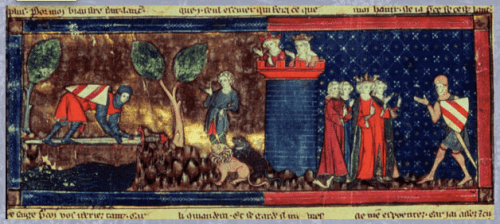
In most versions of the Gwenhwyfar abduction story, the abductor is Melwas, also known as Meleagant, or the “Summer King”, whose name means “princely youth.” Melwas holds Gwenhwyfar captive in his tower for nearly a year. In later versions, the kidnapper is Arthur’s own nephew-son Mordred and the end comes with the Battle of Camlann, with Arthur killing Mordred and receiving in turn the grievous wound that leads to his departure for Avalon. It is important to recognize here that in some versions of the Lancelot story, the kidnapper is Lancelot himself and the action is simultaneously a kidnapping and a rescue. In these versions of the story, Gwenhwyfar has been sentenced to be burned to death due to her betrayal of the king and Lancelot transports her to Joyous Gard for her own safety.
This is too strong a parallel to ignore. As we’ve discussed several times elsewhere now, what if Aerys knew of Lyanna’s deception as the Knight of the Laughing Tree? Would his son stand by as he threatened to burn the daughter of a Lord Paramount for an imagined slight? We know from Ser Jaime that the King’s “Justice” in those days, Aerys’ preferred method of dealing with all who displeased him, was fire. We also know that he was paranoid and held a grudge. What if Aerys himself, following the tourney, sent men to seize Lyanna Stark as she travelled to Riverrun for her brother’s wedding, with the intent of bringing her to face “Justice”? Might Rhaegar and the knights closest to him not have staged a rescue? Can we find the logic in shifting the role of Lancelot to Rhaegar?
The Melwas and Mordred versions also have clear parallels to the Rhaegar-Lyanna story. If we once again shift analogies and treat Rhaegar, the “abductor”, as Melwas, the “princely youth”, the captivity is a direct parallel. A parallel also exists between the dramatic Battle of the Trident, where Rhaegar would be killed by his cousin Robert Baratheon, and the Battle of Camlann, where Mordred lost his life to his kinsman Arthur, both deaths coming as revenge for a kidnapping. Incidentally, in the aftermath of Camlann it’s said that Gwenhwyfar went to her deathbed filled with guilt for the lives lost in her name, as I have always imagined Lyanna Stark must have done following the Trident.
So here is the justification for shifting the role of Lancelot to Rhaegar: the reverse path from Mordred/Rhaegar, who perished at Camlann/Trident, to Melwas/Rhaegar, the “princely youth” who held the queen “captive” in his tower, to Lancelot, who rescued the queen from the fire, all playing the same role of “abductor.” Viewing Rhaegar through the lens of Lancelot adds a new dimension to the romantic nature of R+L, since as seen in Chretien de Troyes “Knight of the Cart” the rescue preceded the love affair. Lancelot is at once an archetypal hero and a villain, a dichotomy that becomes highly relevant to the character of Rhaegar Targaryen.